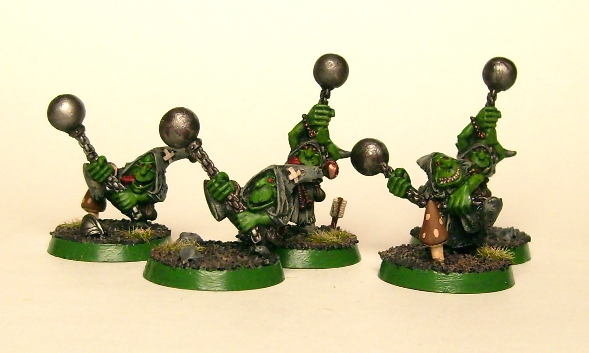Night Goblin Fanatics
by Avian
Warning!
While none of the tactics listed here are illegal (or at least cannot be proved to be illegal!), some of them will doubtlessly be considered unsporting and unfair by many players. When this is the case I will give due warning as to what the issues are and you will have to decide for yourself what to do about it. Be aware that your opponents may react negatively if you use these tricks against them and don't blame me if you lose your friends!
That being said, being sneaky with Fanatics can be heaps of fun and I don't think any Goblin player should be accused of playing unfair if he resorts to nasty tricks, as this is only playing in character. I will claim, though, that I am not suggesting that you use all of these tricks, I am just pointing out weaknesses in the rules. If you find the tricks listed here immoral, then you will at least be prepared if you ever fight against a greenskin player that resorts to them.
Fanatics have been in this game at least since third edition (when you used a template centered on the model to see who was hit) and have gone through four generations of rules and four generations of models since then. The current ones are quite badly written - it looks like they just took the sixth edition rules and cut them in half with a pair of scissors - which opens up a lot of possibility for 'creative' use of them. I am not personally a huge fan of them, as though they add to the comedy element of the army, quite often I feel that I am paying too much for what I get out of them.

Contents
Attributes of Night Goblin Fanatics
Launching Night Goblin Fanatics
- The quick launch
- The slow launch
- The catapult launch
- The wheel launch
- The reform launch
- The building launch
- Launch on re-entry
- Reducing the size of enemy units
- Killing fragile enemy units
- Protecting war machines
- Disrupting movement

Attributes of Night Goblin Fanatics
As always, understanding how something works is the key to using it effectively. This is especially true for Fanatics, who have a lot of odd special rules. For the first printing of the army book, the Fanatic rules were even more of a mess than normal, as they had not thought to include the Immune to Psychology rule for them, which amongst other things meant that they would have to take Panic tests if nearby units were destroyed or broke from combat.
Plentiful
While some other armies out there have Core units that are quite nasty and can do some damage, the same is not true for Goblins. Pretty much everything that is halfway decent at killing stuff is either a character or a Special or Rare unit. Fanatics are an exception to this; you can include up to three per Night Goblin unit in your army and with Night Goblins being a bit better than common Goblins in the new army book, it is easy to field enough Night Goblin units for a dozen or more Fanatics, even in a mixed greenskin army.
That being said, there is seldom a reason to include that many Fanatics in an army. Some greenskin players ask if it would be unsporting to include a dozen Fanatics in an army, without realizing that this is usually far more than you need.
Expensive
What really limits how many Fanatics you want is the fact that at a cost of more than eight basic Night Goblins, taking more than three or four quickly becomes very expensive. By themselves Fanatics are not going to achieve much, it is as a support element for your units and a disruptive element for the enemy army that they really shine and without an army to take advantage of that, there isn't much point in them.
And not only are Fanatics expensive by themselves, they also make their carrier unit more expensive and it is easy to more than double the cost of a small unit of Night Goblins simply by adding Fanatics. Now, it must be admitted that including Fanatics will often make the carrier unit somewhat more difficult to take out, but not excessively so, and it is easy to lose a lot of Victory points when wimpy units outfitted with lots of Fanatics run off the table in Panic. Especially new players should be aware that too many Fanatics can often be a bad thing. A good rule of thumb I tend to go by is that the Fanatics included in a unit should not cost more than half the carrier unit itself (including any characters in the unit). Thus a 64-point unit of twenty Night Goblins should not have more than a single Fanatic, while a 120-point unit with a Big Boss can have up to three Fanatics. Though of course this can be varied now and then to keep your opponent uncertain.
If you do end up taking a lot of Fanatics for a cheap unit, then some care should be taken to protect the carrier unit after it has released its loonies. Your opponent will certainly make an effort to take out that small, weedy unit which has suddenly turned out to be worth twice as many VPs as he first thought, so there is no reason to make it easier for him. A basic 64-point unit of gobbos can be happily sacrificed if you need to, while you should be a lot less reluctant to do the same with a 139-point unit. When the carrier unit is only a cheap, support unit, try to withdraw it from the worst of the action after you have sent away the Fanatics. If possible, go find a quiet table corner to hold.
Hidden
Fanatics are not placed on the table before they are released, which opens up a lot of options. Some players you will meet will immediately assume that each unit has the maximum of three Fanatics and step very warily around them. Quite a few times have opponents moved fast cavalry or similar units carefully up to my Night Goblin units, obviously intending to draw out Fanatics which actually aren't there. This in turn have set up the fast cavalry unit for a nice charge or volley of missile fire in my turn. It would seem that these players have either had a nasty run-in with the spinning loonies at some point, or heard a horrible story from someone else who did. This psychological warfare is a large part of getting anything useful out of Fanatics and if you are too predictable in this regard you are losing out. I am not a terribly great fan of Fanatics myself and will more often than not go entirely without them, or only include one per unit. Thus when I suddenly do include three Fanatics in one unit and unleash them on a regular opponent, they can do a lot more damage than if they were prepared for it. Even better, in our next battle, they will be unsure if I have included three Fanatics, as last time, or no Fanatics, as I normally do.
Release
When the distance between the carrier unit and an enemy unit is 8" or less for the first time, all the Fanatics in that unit gets released. Now, it is important to realize that you can release the Fanatics from any point on the edge of the unit and in any direction out from the unit. People often get the various editions of the rules mixed up and think that they still have to send the Fanatics against the enemy unit that triggered them, but this is absolutely not true. If the Fanatics get triggered early by an enemy unit hiding in a wood nearby, you don't have to send the Fanatics spinning into the wood, you can send them off in a completely different direction. Some people even consistently launch their Fanatics from the centre of the unit's side, even when that would be a waste. It is also important to realize that in this edition the greenskin player always chooses the direction he wants to send off a Fanatic in, whereas in a previous edition the loonies would be sent out in random directions if an enemy unit was suddenly closer than 8". This means that instead of non-greenskin players thinking out nasty ways of getting close to carrier units without ever being exactly 8" away, this task has now falling on the employers of Fanatics.
Obviously, if you want to hit a unit, you send the Fanatics out from the closest point on the carrier unit, aimed at the closest point on the enemy unit. If you are launching multiple Fanatics from the same unit, then you can launch them from the same point as long as you aim them in slightly different directions.
A lot of anti-Fanatic tactics revolve around triggering Fanatics so that they are launched before the greenskin player would like them to be. Quite often very quick units are used for this purpose, such as fast cavalry and units of flyers, such as Chaos Furies. The risk of this can be reduced using several different methods, the first and foremost being to not be so predictable. If you are always fielding a single unit of Night Goblins and always give them threee Fanatics, then it becomes easy for your regular opponents to develop counter-tactics. However, if you on the other hand field several potential carrier units and vary the number of loonies they have, it becomes much more difficult for your opponent. The triggering distance of 8" is also quite far, and if you place several Night Goblin units close together then your opponent will easily be able to get a single unit within 8" of all of them, triggering all the Fanatics at once. Thus you will want to spread your units out a bit, to avoid this. You can even keep your Fanatics a bit behind your other units, forcing the enemy units to get right up under your nose if they want to trigger any loonies.
Another approach is to make an effort to take out potential triggering units as soon as possible, before they get to act. This only really works if you get the first turn, which the average greenskin army gets around one third of the time (since a greenskin army tends to have more units than the opponent). Magic missiles such as the Gaze of Mork or Brain Bursta is good for frying those fast and fragile support units and is probably your best bet.
Further movement
In the turns after a Fanatic has been released it will move 2D6" in a random direction, dieing instead of moving if a double is rolled for distance. It is worth noting here that it was claimed in one WD that you could choose the distance if you rolled a 'Hit' on the Scatter dice. This is not true and the writer of the article appears to have been confused on the matter. Possibly it was a test rule that never made it into the finished army book. In any case, there is not a lot you can do about the direction the Fanatic moves in, and since they move in the compulsory movement phase, you can't hope to place another friendly unit in the way to increase their move distance (see 'the catapult launch', below). Thus movement after the initial release is pretty much in the hands of the dice gods and nothing there is any point in worrying about.
An interesting detail about Fanatic movement is that when it hits a unit it passes through it an out on the other side, something that can significantly increase its movement. Against large armies with lots of cheap troops tightly packed, this makes up for the fact that each individual enemy unit will not be all that bothered by the hits done.
Lastly, a little tip: When rolling the Scatter dice to determine the direction the Fanatic moves in, roll the dice quite close to the model. This makes it much clearer which direction the little nutter is moving in and you avoid heated discussions when it looks like he might just hit a juicy target.
Force of destruction
A Fanatic cannot be fought in combat or - now that we have an FAQ for the army book - scared away by Panic. This means that the only way of getting rid of them is to either zap or shoot them, or wait until they kill themselves by accident. Any missile weapon aimed their way also receive the normal -1 to hit penalty for shooting at a single, small target and the fact that a unit can no longer split its fire between two or more targets means that a Fanatic can be quite difficult to get rid of. Any magic missile that hits them will burn them to a crisp the vast majority of the time, but considering how random they are and that this will gain the opponent no Victory Points at all, is acceptable. Some armies have little or no missile fire available, which also increases the life-expectancy of your ball-swinging maniacs.
Splat!
A Fanatic that moves through a unit will cause D6 S5 armour piercing hits to it. When a unit moves through a Fanatic, they will also take D6 hits and if they end their movement on top of the Fanatic they take a further D6 hits, which kills the Fanatic. Now, even at Strength 5, D6 hits is not terribly dangerous and models with a 3+ armour save or better even get armour saves against the hits (though not very good armour saves unless they have a 1+ save to begin with). For a decent-sized unit, Fanatics by themselves are not all that scary, unless the greenskin player rolls a very high number on the D6, the unit gets hit by more than one Fanatic or it takes 2D6 hits from the same Fanatic. Each Fanatic will only cause about 3 casualties to Toughness 3 victims, or 2 casualties to Toughness 4 victims. Some players believe that Fanatics should do less damage to skirmishing units; this makes little sense, as it is much easier to plow through a spread-out group of people then a densely packed one and if anything the Fanatic should do more damage to skirmishers, realistically speaking.
The effect the potentially high damage a scattering of Fanatics around the table will have depends a lot on the opposing player and the army he or she plays. Some people will plow recklessly through the loonies even when they should be more careful, while others are excessively hesitant when the risk is low for them. In any case, several Fanatics close together makes it much more likely a lot of damage will be caused and that the opponent will attempt to do something about them. As a greenskin player, you should not be afraid of moving through your own Fanatics if they are in your way.
If you are lucky, hits from a Fanatic may force a unit to take a Panic test, which can cause it to run away. In this regard it is important to get the timing right. It is for example important to note that each Fanatic will cause hits immediately after moving through a unit and that a unit that a unit that suffers 25% or more casualties must take an immediate Panic test. Therefore, a unit can potentially be panicked from the first Fanatic released and run away, in which case the following Fanatics can be released in a different direction. Similarly, a unit that charges through a Fanatic and would end its move on top of it should resolve the first D6 hits as soon as the unit contacts the Fanatic. As the unit is not in close combat yet, these hits can potentially cause a Panic test, whereas the second D6 hits, caused by ending the move on top of the Fanatic and in contact with the greenskin unit cannot cause Panic, as units in close combat don't take Panic tests. It is also worth noting that a unit that flees due to hits from a Fanatic will do so towards the closest table edge. Should the unit that released the Fanatics be in between a fleeing enemy unit and that closest table edge, the enemy unit is destroyed, as per the normal fleeing rules. This might for example happen if the unit was charging a Night Goblin unit on the greenskin side of the table, got splatted and fled forward instead of away. Great fun!
It is also worth mentioning the little Magic Item, the Mad Cap Mushrooms, which lets you re-roll the number of hits when the Fanatic is first released. With this very worthwhile item you can re-roll the number of hits an enemy unit takes if you roll below average (i.e. 1, 2 or 3 hits) and the number of hits your own unit takes, if you roll above average (for those occasions when it pays to send the Fanatics spinning through a friendly unit). On average this item will increase or decrease the number of hits caused by each Fanatic by 0.75.
Out of control
In addition to the aforementioned cases where a Fanatic might die (being shot or zapped, rolling a double for its movement in a turn after it was released and a unit ending its move on top of it), a Fanatic will die in a couple of other cases. The first is when the carrier unit flees before its Fanatics have been released, which neatly solves an old rules-oddity. To reduce the chance of this happening, keep units with several Fanatics close to your General and/or Big Red Raggedy Banner. This little rule also means that fleeing from a charge with a unit containing Fanatics is something of a bad idea, though losing the Fanatics but saving the unit is not necessarily a bad thing. The last case is when it moves into contact with a terrain feature of any kind, apparently including those types who are classified as open terrain. Personally I find it ridiculous that a Fanatic should be killed for moving across a piece of open ground and if your opponent insists on playing it that way, you have my full blessing to employ all the nasty tricks below against him.
That being said, Fanatics tend to do better away from terrain. One of the most annoying ways of having your Fanatics triggered too early is when a unit of Scouts sneaks through a wood in their first turn, before you have had a go, getting within 8" of a carrier unit. The Fanatics must be released, but it is pointless to send them against the unit in the wood and all other enemy units are so far away that the Fanatic will probably never hit them.
And in case you were wondering: two Fanatics colliding do not automatically kill each other any longer. Instead they just do damage as normal - so each has about a one in thirty-six chance of survival!

Launching Night Goblin Fanatics
How to use Fanatics mainly involve launching them; when it is done, adjusting how far they move and getting them to hit what you want. A lot of these tricks are bordering on illegal and a lot of people will certainly consider them to be so. However, I would not suggest anything that can be proved to be against the rules and even if a lot of people will consider this stuff to be illegal, there is nowhere in the rules where this is actually stated. It might not be in good taste to use all this tricks and I certainly would not recommend them as a way of getting more friends.
Note that the term 'Fanatic Slingshot' can refer either to what I call 'the wheel launch' or 'the catapult launch'. To avoid(?) confusion, I have made up two different terms for these two quite different tactics.
The quick launch
This one isn't even remotely dodgy. If you want to get a Fanatic to do a decent amount of damage to the enemy and little damage to your side, getting them across the table as soon as possible is a good idea. One full 8" move forward by the carrying unit and any Fanatics released will on average get into the enemy half of the table, where they should hopefully find some nice targets.
The slow launch
When an enemy unit charges a Night Goblin unit containing Fanatics, you will often want them to end the charge move on top of the Fanatic, since they will then take 2D6 hits instead of just D6. This will most often happen when the Fanatics roll very low for their launch move, or the enemy unit is very deep. You can better the odds somewhat, though. If you launch them diagonally across the space between your unit and the enemy unit, the path before they hit the enemy unit will be longer and there will be a greater chance of the Fanatics stopping in between. You do this by selecting, say, the far right corner of your unit as the point to be launched from and the far right (i.e. the far left from your point of view) of the enemy unit as the point to be aimed at. Assuming normal unit widths, you would then probably need to roll something like a 10 to hit the unit, giving a much greater chance of the Fanatic ending up in the path of the unit.
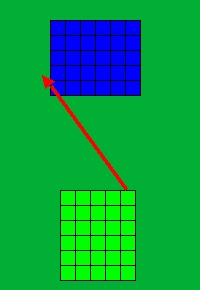
A variant of this tactic (which your opponents may or may not be upset about) is to launch the Fanatics from a point inside or on the far side of the carrier unit, to further reduce the effective distance the Fanatics move. This is technically legal, as Fanatics can be launched from any point on the unit and in any direction (including back into it), though it's likely that it is only legal because the writers never thought of the idea. In any case, the carrier unit will take damage when this trick is used, so it might not actually pay off at all if you are unlucky with the distance rolls.
The catapult launch
One way of making sure that the Fanatics hit their target, is to place another friendly unit (hereafter called "the poor suckers") between the enemy unit and the unit the Fanatics is launched from. By sending the Fanatics spinning through the poor suckers, a short roll that would normally just result in the Fanatics stopping short of their target will now be increased since a Fanatic that would end its movement inside a unit is moved out on the other side. Now, if the distance between the poor suckers and the enemy unit is one inch or less, they will automatically hit that unit as well and move through them. Ideally you want a bit more than 7" between the carrier unit and the other side of the poor suckers, as this will halt a charging enemy unit just out of contact with the poor suckers. If your poor sucker unit is, say, 6 Goblins deep and placed 6 cm away from the carrier unit, then any roll for distance other than a double 1 will see the Fanatics passing through both units. If you have a poor sucker unit 7 Goblins deep placed 4 cm away from the carrier unit, then the Fanatics will automatically hit both units. 3D6 hits, both to your unit and to the enemy unit. Pretty much automatic.
This tactic is greatly improved by having a character with the Mad Cap Mushrooms in the carrier unit. This magic item will let you re-roll any dice showing a high number of hits for your own poor suckers unit and any dice showing a low number of hits for the enemy unit. I once got 6 hits for my own unit and 16(!) hits on the enemy unit in this way. Not surprisingly the enemy unit (some Saurus Cavalry) were wiped out completely. I don't think I have laughed so well in years!
Naturally, whatever you do, you don't want to send Fanatics spinning through any of your own units that are especially expensive and/or fragile. Be aware that if the poor suckers suffer 25% or more casualties, they will have to take a Panic test. A large unit of cheap Goblins is a good poor suckers unit, though cheap Orc Boyz (more resilient to damage), Snotlings (immune to Panic) or Trolls (Toughness 4 and Regenerate) will also work.
A variant of this tactic involves a poor sucker unit that is already in combat and sending Fanatics through them. This cannot cause Panic in the enemy unit, though on the other hand it cannot cause Panic in your own unit either.
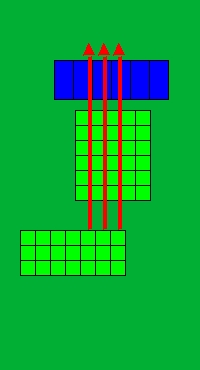
The wheel launch
This one is a bit dodgy, though going by the rules it is perfectly legal. What you do is to take a carrier unit of a bit more than minimum size. About 23 is usually required. I suggest you give them short bows, as this makes the nest step seem a lot less suspicious. You then deploy it right at the front of your deployment zone in a single, very long line, one Goblin deep (fig. 1). Now, in your first turn you turn the formation 90 degrees to the left or right, so that you get a unit that is one Goblin wide and 23 Goblins deep (fig. 2). Then the unit makes a 90 degree wheel so that it ends up facing away from the enemy (fig. 3). What will happen when you do this, is that the rear end of the unit swings out, making a huge wheel and ends up within 8" of the enemy army. The Fanatics are then released from a point 8" away from the enemy deployment zone. This works because the distance the unit counts as having moved is equal to the distance moved by the goblin in the front rank, who only moved about an inch and a half.
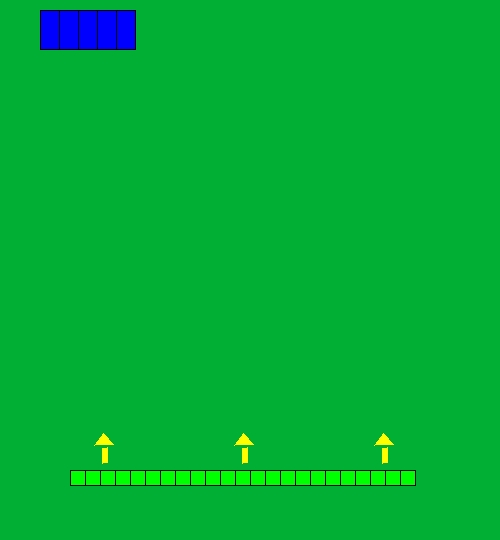 |
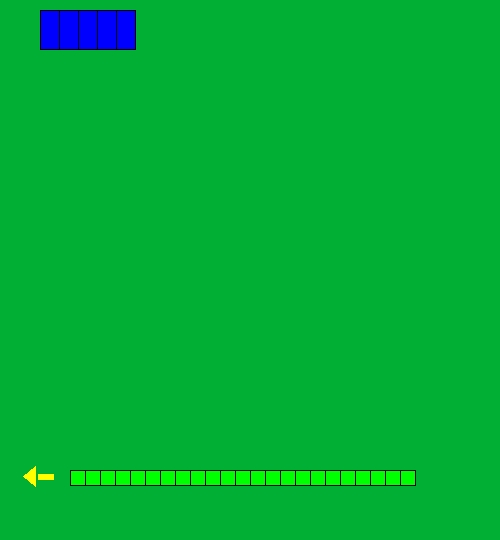 |
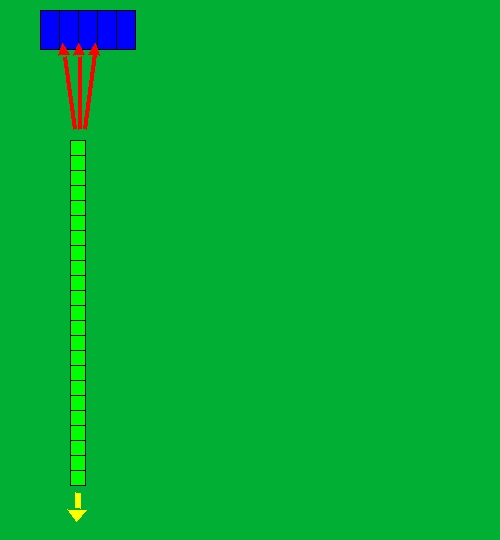 |
| Fig. 1: Initial position, gobbos facing forward | Fig. 2: Gobbos turn 90 degrees, facing left | Fig. 3: Gobbos wheel 90 degrees left, facing own table edge and launching Fanatics from rear end of unit |
The plan is not fool proof, but then what plan involving Goblins is? The most obvious obstacle is that it requires a great open space in front of the Goblin unit to be wheeled past. If your opponent gets the first turn, or if there is terrain in the way, this plan will probably not work. Furthermore, your opponent will probably object. The rule that says how a wheel is measured obviously did not foresee units that are twenty-three times deeper than they are wide; even though a wheel will always result in the models in rear ranks moving a bit further than models in the front rank, it is rarely as extreme as this. Another disadvantage is that your unit ends up in a very awkward position and will almost certainly get beaten and destroyed if you allow it to get charged.
Note that the most common objection to this trick is 'models are only allowed to move up to a maximum of twice their Movement value', but that limitation applies to reforming, not to wheeling. The wheel launch is perfectly legal, but relies on exploiting a loop-hole in the abstract way that units in Warhammer wheel, which is necessitated by the fact that our movement trays are not bendable.
The reform launch
A little trick for getting Fanatics released when you are less than 8" away from the enemy unit is to (ab)use the Reform rule. Let's say you have a carrier unit of 20 Night Goblins arranged 5 Goblins wide and 4 deep. 10" off to your right is the enemy unit you want to hit. In your own Movement phase you reform into a formation one Goblin deep and twenty Goblins wide, keeping the centre of the unit in the same place, as you must. Suddenly the enemy unit is only 4" away and the Fanatics will almost certainly hit the enemy unit.
This little tactic hinges on the fact that when reforming, the carrier unit is never actually 8" away, you just go from a 5 x 4 formation to a 20 x 1 formation with no step in between where you could freeze the procedure and launch the Fanatics. Your opponent might suggest that you do a temporary in-between step where the formation is such that the distance between the units is 8", but as an employer of low-down dirty tricks you should of course point out that this is not how a Reform is done and refuse.
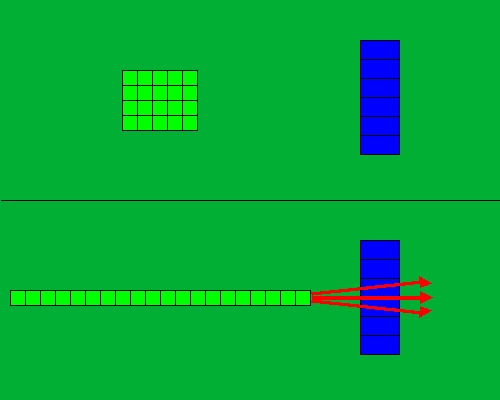
The building launch
This trick can be used if there are buildings on the battlefield. Let's say that there is an enemy unit on one side of a building, less than 8" away from it. On the other side of the building, less than 4" from it, is one of your carrier units. The building itself is so large that the distance from the enemy unit over to the other side of the building is more than 8" - if the distance is less than this, the tactic will not work. The carrier unit moves up to the building and enters it, which immediately makes the edges of the building count as the edges of the unit. Since the building is less than 8" from the enemy unit, the Fanatics are launched immediately and will have a higher chance than normal of hitting the enemy unit. This tactic circumvents the rule that Fanatics die when they hit a terrain piece since the Fanatic is never actually in contact with the building - it is either hidden inside the unit or outside the building. Obviously the other gobbos in the unit are chucking the Fanatics out the door and barring it behind them.
Launch on re-entry
Here is a little trick to get revenge on an enemy unit that has smashed into your battle line, destroyed one of your units and pursued off the table. The unit will have to return to the same spot it left the table from in its next turn, so if you move a carrier unit close to the entry point, you can be almost certain of hitting the enemy unit when it placed back on the table. Your Fanatics will be destroyed from moving off the table, but they would probably have been released behind your lines soon afterwards anyway, so it's not exactly a loss.
A similar trick can be used against troops that dig their way onto the battlefield. Place a carrier unit on top of the marker and the emerging Tomb Scorpion or Gutter Runner Digging Team will almost certainly be hit when they emerge. Or, when facing an Ogre Kingdoms army with those nasty Gorgers, take a carrier unit and deploy it in a single, long line near your own table edge. Should a Gorger decide to show up anywhere nearby, it will get a welcome it will not forget in a hurry.

Using Night Goblin Fanatics
Finally, having listed all those more or less dubious tricks for getting the Fanatics where you want them, when you want them there, it might be appropriate with a little section on what it is you are really trying to achieve with them. A lot of use can also be gotten out of the fact that your opponent does not know how many Fanatics each of your Night Goblin units contains, as described for 'Hidden' above.
Reducing the size of enemy units
Considering that getting hit by only one Fanatic isn't really all that dangerous and that consistently getting more damage tends to require more Fanatics, more effort and in some cases quite specific circumstances, here is a use that is relatively straight forward. What you do is take a Night Goblin unit that you intend to use to support your main combat units (see my article on the Uses for Goblin Infantry for more on this subject), for example to flank charge any enemy unit that charges your main unit but fails to break it. Give that unit a single Fanatic and deploy it close to the unit it is set to support as normal. When a unit charges your main unit it will get within 8" of your carrier unit, triggering the Fanatic. Choose a point close to your main combat unit and pick a direction so that regardless of how short you roll, the chargers will move though the Fanatic and take hits (it is generally neither necessary or useful to send the Fanatic through your own unit in this case). This should reduce the size of the enemy unit, possibly knocking off a point of rank bonus and/or giving your main unit outnumbering. Especially the more expensive greenskin units benefit from this, as buying them in large numbers if quite expensive. For very small units, getting hit by a Fanatic may reduce the number of models able to fight - one fewer Chosen Knight attacking you is always a good thing and a Fanatic has a better than even chance of killing one of these brutes.
By keeping the carrier unit a bit further back than the unit is it set to support, you are also increasing the chance of having the enemy unit end up on top of the Fanatic, similar to what is described for 'The slow launch' above.
Killing fragile enemy units
Some non-greenskin players think that quick fast cavalry units and even quicker units of flyers are great for triggering Fanatics before the greenskin player would like them released. I disagree; I think that Fanatics are great for taking out those pesky fast cavalry and flyer units that can other wise be very bothersome to get rid of. Being hit by even a single Fanatic should seriously ruin such a unit's day and it certainly helps if they act in a suicidal manner. Artillery is usually wasted on this type of support unit and in addition to spells, Fanatics give you a way of dealing with them.
Protecting war machines
Linked to the above is neutralizing those quick support units who are out to take out your war machines. Greenskins lack units that are good at protecting war machines, but units with Fanatics come close. They can be deployed close to your war machine batteries, protecting otherwise vulnerable routes to them. Take care that you don't place the carrier unit so that the Fanatics can be triggered from a safe position behind friendly units (unless you are happy to send the spinning loonies through your own unit as well, that is) or behind terrain. Remember that there will always be a 'blind zone' when you do war machine protection duty - the spot directly behind the war machine as seen from the carrier unit. If the enemy unit moves through this blind zone, it can be hard to hit him with Fanatics and you must either send them the long path around the war machine or directly through it (which will on average kill one crew per Fanatic).
Disrupting movement
One of the great things about Fanatics is how they create a little circle around themselves where enemy units are reluctant to go (small, fragile units being more reluctant than large, resilient ones). While a single Fanatic isn't likely to worry more than excessively expensive and wimpy units, if there are multiple Fanatics scattered around the area, even quite tough units will tend to walk softly. If you are playing more on the defensive, then this can be a good thing, as it gives you more time to shoot or zap the enemy force as it tries to navigate safely through the loonies. Alternatively, if there is an area on the battlefield you want the opposing army to stay away from - for example because you want to stop enemy reinforcements getting to where they are needed, then a handful of Fanatics seeded through the area will greatly aid in this. If you are playing a more offensive army against an opponent that is more defensive, then Fanatics are more likely to disrupt your own movement, which is seldom a very good thing!
Disruption is obviously more effective if you spread the Fanatics out a bit, as they will cover a larger area (and have less of a chance of hitting each other). You could even use some of the Fanatics in a unit for disruption, while others are aimed at doing damage right away. If you find that the first loony you launch end up where you want it and does enough damage (remember that each Fanatic is resolved one at a time), then you might send the others off to get in the way of other enemy units.

Other related articles
| Back to the Orcs & Goblins Tactics page | Back to the Main page |
